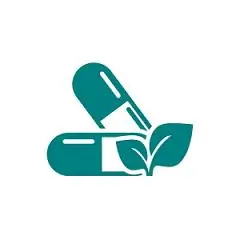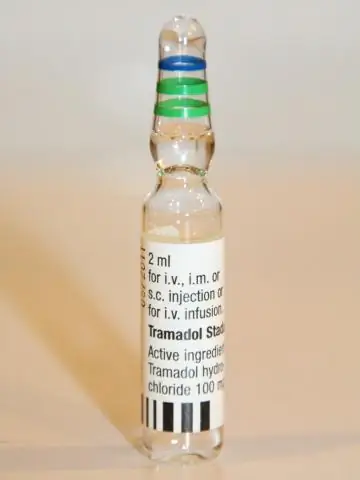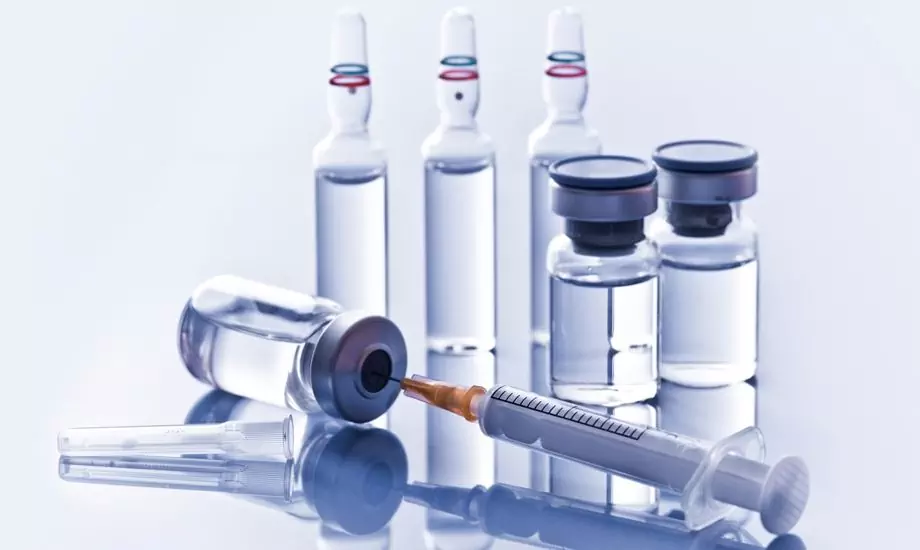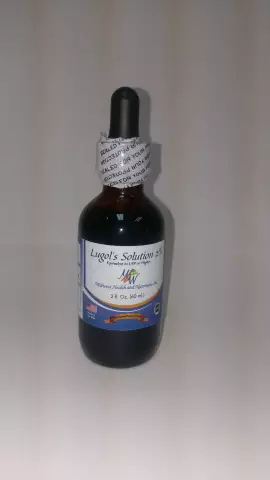- Author Rachel Wainwright [email protected].
- Public 2023-12-15 07:39.
- Last modified 2025-11-02 20:14.
Morphine hydrochloride
Morphine hydrochloride: instructions for use and reviews
- 1. Release form and composition
- 2. Pharmacological properties
- 3. Indications for use
- 4. Contraindications
- 5. Method of application and dosage
- 6. Side effects
- 7. Overdose
- 8. Special instructions
- 9. Application during pregnancy and lactation
- 10. Use in childhood
- 11. In case of impaired renal function
- 12. For violations of liver function
- 13. Use in the elderly
- 14. Drug interactions
- 15. Analogs
- 16. Terms and conditions of storage
- 17. Terms of dispensing from pharmacies
- 18. Reviews
- 19. Price in pharmacies
Latin name: Morphine hydrochloride
ATX code: N02AA01
Active ingredient: morphine hydrochloride (Morphine hydrochloride)
Manufacturer: Federal State Unitary Enterprise "Moscow Endocrine Plant" (Russia); RUE "Belmedpreparaty" (Republic of Belarus)
Description and photo update: 09.10.2019

Morphine hydrochloride is an analgesic drug.
Release form and composition
The drug is produced in the form of a solution for injection, transparent, colorless or with a pale yellow tint [1 ml in an ampoule, in a cell contour packaging 5 ampoules, in a cardboard box 1 or 2 packages and instructions for use of Morphine hydrochloride, in a cardboard box 34 packages - for hospitals; 1 cm 3 (1 ml) in a syringe tube, in a box of 20, 50 or 100 syringe tubes].
1 ml of the preparation contains:
- active substance: morphine hydrochloride - 10 mg;
- additional components: water for injection, hydrochloric acid 0.1M solution.
Pharmacological properties
Pharmacodynamics
Morphine hydrochloride is an opioid receptor agonist. Due to its inherent pharmacological properties, the drug ensures the achievement of an increase in the threshold of pain sensitivity with stimuli of various modalities, promotes inhibition of conditioned reflexes, exhibits euphorizing, as well as moderate hypnotic effects, excites the vomiting center and increases the tone of the centers of the vagus nerve. It helps to suppress the respiratory center, constriction of the pupil as a result of activation of the center of the oculomotor nerve, increase the tone of the bronchi and smooth muscles of the sphincters of internal organs (biliary tract, intestines, bladder). It causes an increase in the contractile activity of the myometrium, a weakening of intestinal peristalsis and a slowdown in the secretory function of the gastrointestinal tract (GIT).
Morphine hydrochloride slightly reduces basal metabolism and body temperature, stimulates the production of antidiuretic hormone (ADH). Leading to dilatation of peripheral vessels and the release of histamine, it can provoke hypotension, redness of the skin and albuminous membrane of the eyes, increased sweating. Morphine provides an increase in the effect on the central nervous system (CNS) of sedatives, hypnotics, antihistamines with a central component of action, drugs for anesthesia, antipsychotic, anxiolytic and antidepressant drugs. It leads to addiction and drug (opioid) dependence - morphinism.
Morphine hydrochloride exhibits rapid analgesic effects. With epidural administration of the drug, segmental analgesia is produced as a result of blocking of opioid receptors localized in the dorsal horn of the spinal cord, which is involved in nociception, against the background of an extremely low content of the drug in the general circulation system. Due to the low lipophilicity of the active substance, its accumulation in the cerebrospinal fluid provides an increase in the duration of analgesia and the spread of its zone of action in the rostral direction along with the flow of cerebrospinal fluid. With a single epidural administration, the effect lasts up to 24 hours.
As a result of intramuscular (i / m) injections of a solution at a dose of 10 mg, the effect is observed after 10-30 minutes, and reaches its maximum after 30-60 minutes and lasts 4-5 hours. With intravenous (iv) administration, the maximum effect is observed after 20 minutes and also lasts 4-5 hours. After oral administration of morphine, the effect is achieved in 20-30 minutes, with subcutaneous (subcutaneous) injection - after 10-20 minutes and lasts for 3-5 hours or more. After repeated subcutaneous administration, there may be a rapid development of morphinism; in the case of regular oral administration of a therapeutic dose, drug dependence forms a little more slowly (after 2-14 days from the start of administration). Withdrawal syndrome may appear several hours after completion of a long course of therapy and reach a maximum after 36-72 hours.
Pharmacokinetics
The volume of distribution of the active substance is 4 l / kg. The time to reach the maximum concentration of the agent (C max) with intravenous administration is 20 minutes, with intramuscular injection - 30-60 minutes, with subcutaneous injection - 50-90 minutes. Approximately 30-35% of the drug form a bond with blood plasma proteins. Morphine hydrochloride crosses the blood-brain barrier (BBB) and the placenta, can provoke depression of the respiratory center in the fetus, is detected in breast milk.
The products of the metabolic transformation of the active substance are predominantly glucuronides and sulfates, the half-life (T 1/2) is 2-3 hours. About 85% of the substance is excreted by the kidneys, of this amount, about 9-12% - over 24 hours unchanged, 80 % - in the form of glucuronides. The rest of the drug, which is 7-10%, is excreted in the bile.
Indications for use
Morphine hydrochloride is recommended for use as an anesthetic for severe pain syndrome against the background of the following diseases / conditions:
- trauma;
- preoperative, operational and postoperative periods;
- severe attacks of angina pectoris;
- myocardial infarction;
- malignant neoplasms;
- other conditions accompanied by severe pain.
The drug is also indicated (depending on the manufacturer) for use in the following cases:
- spinal anesthesia during childbirth;
- general or local anesthesia (including premedication), as an additional drug;
- pulmonary edema against the background of acute left ventricular (LV) failure, as a drug of additional therapy.
Contraindications
Absolute (for all manufacturers):
- conditions accompanied by respiratory depression or severe depression of the central nervous system;
- head trauma;
- increased intracranial pressure;
- paralytic ileus;
- bronchial asthma and chronic obstructive pulmonary disease (COPD);
- hypersensitivity to opiates.
Additional absolute contraindications, depending on the manufacturer:
- convulsive conditions;
- acute alcoholic conditions and alcoholic psychosis;
- cardiac arrhythmias, heart failure associated with chronic lung disease;
- conditions after surgical interventions on the biliary tract;
- pheochromocytoma (due to the increased risk of developing a vasoconstrictor effect caused by the release of histamines);
- undiagnosed acute surgical diseases of the abdominal organs;
- coma;
- age up to 1 year or up to 18 years.
Do not use a solution of Morphine hydrochloride in combination with monoamine oxidase (MAO) inhibitors, as well as within 14 days after the latter is discontinued due to possible severe adverse reactions from the respiratory and vasomotor centers.
Relative (Morphine hydrochloride must be used with extreme caution):
- insufficiency of the adrenal cortex;
- liver and / or kidney disease;
- general exhaustion;
- elderly age;
- pregnancy and lactation (only if absolutely necessary);
- an indication of a history of drug dependence.
Additional relative contraindications, depending on the manufacturer:
- emotional lability, suicidal tendencies;
- abdominal pain of unknown origin;
- convulsions;
- epileptic syndrome;
- surgical treatment of the gastrointestinal tract, urinary system;
- cholelithiasis;
- the period after surgery on the biliary tract;
- severe inflammatory bowel disease;
- arrhythmia;
- pulmonary heart failure in chronic lung diseases;
- strictures of the urethra, prostatic hyperplasia;
- hypothyroidism.
Morphine hydrochloride, instructions for use: method and dosage
A solution of Morphine hydrochloride in ampoules is injected s / c, i / v, i / m, epidural (depending on the manufacturer). Doses of the drug are determined individually, taking into account the condition and age of the patient.
Dosing regimen for adults
Adults are prescribed s / c, as a rule, 1 ml of solution, epidurally - 0.2-0.5 ml of the drug diluted in isotonic sodium chloride solution at a dose of 10 ml. The analgesic effect develops 10-15 minutes after administration and reaches a maximum after 1-2 hours. With subcutaneous injections for adults, the highest single dose is 10 mg, the daily dose is 50 mg.
In the presence of edema, subcutaneous administration of morphine hydrochloride is not recommended. If the patient is prescribed intravenous administration of the drug, 1 ml of the drug must be diluted in 10 ml of 0.9% sodium chloride solution. The resulting solution is injected intravenously slowly, fractionally at 5-minute intervals of 3-5 ml until the pain syndrome is completely relieved.
Dosing regimen for children
For children, morphine hydrochloride is administered parenterally, sometimes in combination with oral morphine in doses ranging from 0.05 to 0.2 mg / kg per dose.
It is recommended to administer the drug subcutaneously at a dose of 0.1-0.2 mg / kg, if necessary, every 4-6 hours, but the total daily dose for children from birth to 2 years should not exceed 15 mg, for children over 2 years - 1.5 mg / kg.
Intravenous Morphine hydrochloride is administered very slowly: children under 2 years old - 0.05-0.1 mg / kg, in the process of constant intravenous infusion at a dose of 0.01-0.015 mg / kg / h; children over 2 years old - 0.05-0.2 mg / kg, with constant infusion - 0.02-0.05 mg / kg / h.
For the purpose of premedication, Morphine hydrochloride should be administered intramuscularly at 0.05-0.1 mg / kg. As a component of general anesthesia, intravenous administration of 0.1-0.5 mg / kg is prescribed. The total total dose for children from 0 to 2 years old should be no more than 15 mg, over 2 years old - no more than 50 mg.
For epidural administration, it is recommended to use Morphine hydrochloride at doses of 0.05-0.1 mg / kg, previously diluted in isotonic sodium chloride solution at a dose of 2-4 ml - for children under 2 years old, at a dose of 4-10 ml - over 2 years old … Anesthesia is noted after 15-20 minutes and reaches a maximum after 60 minutes, the duration of action is 12 hours or more.
Side effects
- digestive system: more often - nausea, vomiting (mainly at the beginning of the course), constipation; less often - dry mouth, spasm of smooth muscles of the biliary tract, gastralgia, anorexia; rarely - hepatotoxicity with signs of cholestasis, with severe inflammatory bowel lesions - paralytic ileus, intestinal atony, toxic megacolon;
- respiratory system: more often - depression of the respiratory center (especially in newborns and children under 1 year of age); less often - bronchospasm;
- cardiovascular system: more often - tachycardia, decreased blood pressure (BP); less often - bradycardia; sometimes - increased blood pressure;
- nervous system: more often - unusual fatigue, drowsiness, general weakness, dizziness, fainting; less often - involuntary muscle twitching, headache, nervousness, tremors, insomnia, paresthesias, impaired coordination of movements of various muscle groups, increased intracranial pressure with the risk of further disturbance of cerebral circulation, depression, confusion, rarely - restless sleep, depression of the central nervous system, in the background large doses - muscle rigidity (especially respiratory), anxiety, paradoxical agitation; with an unknown frequency - nightmares, sedative / stimulating effect (mainly in elderly patients), decreased ability to concentrate, delirium, convulsions, dependence;
- allergic reactions: more often - facial flushing, rash on the face, wheezing; less often - skin rash, itching, hives, chills, laryngeal edema, facial edema, laryngospasm;
- genitourinary system: less often - decreased libido, decreased potency, spasm of the ureters (frequent urge to urinate, difficulty and pain during urination), decreased urine output; with an unknown frequency - spasm of the sphincter of the bladder, impaired outflow of urine or deterioration of this condition, against the background of stenosis of the urethra and hyperplasia of the prostate gland;
- local reactions: hyperemia, burning at the injection site, edema;
- others: more often - dysphonia, increased sweating; less often - miosis, nystagmus, impaired clarity of visual perception, discomfort, euphoria; with an unknown frequency - tolerance, drug dependence, hypothermia, withdrawal syndrome (general weakness, sneezing, yawning, rhinitis, irritability, nervousness, sweating, muscle pain, tremor, nausea and vomiting, diarrhea, mydriasis, tachycardia, hyperthermia, stomach cramps, anorexia, headache), syndrome of inappropriate secretion of ADH.
Overdose
Symptoms of acute and chronic overdose of Morphine hydrochloride may include: miosis (in case of significant hypoxia, pupil dilation is possible), hypothermia, dryness of the oral mucosa, severe weakness, drowsiness, dizziness, nervousness, anxiety, cold clammy sweat, lowering blood pressure, confusion, bradycardia, slow breathing difficulties, muscle rigidity, intracranial hypertension (up to cerebrovascular accident), seizures, delirious psychosis, hallucinations, in severe cases - loss of consciousness, coma, respiratory arrest.
First aid for overdose - taking measures to maintain cardiac activity and adequate pulmonary ventilation. To quickly restore breathing, an intravenous specific antagonist of opioid analgesics is prescribed - naloxone (Narkan) at a dose of 0.4-2 mg, if there is no effect after 2-3 minutes, re-administration of the drug is possible, but not more than 10 mg per day. For children, the starting dose of naloxone is 0.01 mg / kg.
It is required to take into account the possible risk of withdrawal from the use of naloxone and nalorphine in patients with dependence to morphine, in such cases, it is recommended to increase the dose of antagonists gradually.
special instructions
It is forbidden to drink alcohol during treatment.
When the patient is about to undergo heart surgery or other surgical intervention, accompanied by intense pain, the use of Morphine hydrochloride should be discontinued 24 hours before the proposed operation. If therapy is shown in the future, then the dosage regimen must be selected depending on the severity of the surgical intervention.
If nausea and vomiting occur during treatment, the drug can be used in combination with phenothiazine. In order to reduce the side effects of morphine on the intestines, laxatives are recommended.
The use of morphine hydrochloride against the background of therapy with drugs such as antidepressants, anxiolytics, antipsychotics, hypnotics and anesthetics is allowed only under medical supervision and in reduced doses, due to the risk of excessive depression of the central nervous system and suppression of the activity of the respiratory center.
It should be borne in mind that children under 2 years of age are more sensitive to the action of opioid analgesics, and therefore, they may also develop paradoxical reactions.
Influence on the ability to drive vehicles and complex mechanisms
During the period of treatment, it is not recommended to drive vehicles and other potentially dangerous and complex mechanisms and devices.
Application during pregnancy and lactation
During pregnancy, childbirth and lactation, the use of Morphine hydrochloride is allowed only for health reasons, due to the aggravation of the threat of drug dependence in the fetus and newborn.
Pediatric use
In children over 1 year of age, the pharmacokinetics of morphine hydrochloride is comparable to that in adults, after intravenous administration, T 1/2 is 2 hours.
For children (depending on the manufacturer), the drug can be used from the day of birth, from 12 months or from 18 years.
With impaired renal function
In the presence of impaired renal function, drug therapy should be carried out with caution.
For violations of liver function
In the presence of functional disorders of the liver, morphine hydrochloride should be used with caution.
Use in the elderly
Elderly patients are required to use Morphine Hydrochloride with caution.
Drug interactions
- beta-blockers: an increase in the inhibitory effect on the central nervous system is possible;
- narcotic analgesics belonging to the group of partial agonists (buprenorphine), agonists-antagonists of opioid receptors (butorphanol, nalbuphine, tramadol), dopamine: there is a risk of reducing analgesia and the occurrence of withdrawal syndrome in persons with dependence on opioids; the combination is not recommended;
- derivatives of barbiturates and phenothiazine: the hypotensive effect increases and the risk of respiratory depression is aggravated;
- chlorpromazine: an increase in the sedative, miotic and analgesic effects of morphine is recorded;
- other opioid analgesics: there is depression of respiration and central nervous system function, as well as a decrease in blood pressure;
- zidovudine: there is a suppression of the hepatic metabolism of this substance and a decrease in its clearance, the danger of mutual intoxication of drugs increases;
- naltrexone: the onset of withdrawal symptoms is observed against the background of drug dependence (they can be noted already 5 minutes after the administration of the drug and continue for 48 hours, they are distinguished by the persistence and complexity of the elimination process);
- cimetidine: increased respiratory depression;
- mexiletine: there may be a violation of the absorption of this substance;
- drugs that lower blood pressure, including diuretics, ganglion blockers: an increase in the hypotensive effect of these drugs is recorded;
- drugs that exhibit anticholinesterase activity, antidiarrheals (including loperamide): the risk of depression of central nervous system function, urinary retention and constipation, up to intestinal obstruction may be aggravated;
- metoclopramide: the effect of this substance is reduced;
- aminophylline, sodium salts of barbiturates and phenytoin; sodium acyclovir, fluorouracil, doxorubicin, sodium heparin, furosemide, tetracyclines, promethazine hydrochloride (Diprazine, Pipolfen): the incompatibility of these drugs with morphine has been established;
- bromides, iodides, tannin and tannins, oxidants, alkalis and substances with an alkaline reaction: the use of morphine hydrochloride is incompatible with these agents, since it is destroyed in an alkaline environment (during the reaction with oxidants, a more toxic metabolite of morphine is formed - dioxymorphine, and when combined with alkalis, the base of morphine precipitates).
Analogs
Morphine hydrochloride analogs are Morphine sulfate, Morphine, MCT Continus, DHA Continus, Morphine long, etc.
Terms and conditions of storage
Store out of the reach of children, protected from light penetration, at a temperature not exceeding 20 ° C.
The shelf life is 3 years.
Terms of dispensing from pharmacies
Dispensed by prescription.
Reviews of Morphine hydrochloride
Due to the fact that there are currently no patient reviews about Morphine hydrochloride on medical websites, it is not possible to make a real assessment of its effectiveness and disadvantages.
Price for Morphine hydrochloride in pharmacies
There is no reliable data on the price of Morphine hydrochloride in ampoules, since the drug is not currently sold in pharmacies.

Anna Kozlova Medical journalist About the author
Education: Rostov State Medical University, specialty "General Medicine".
Information about the drug is generalized, provided for informational purposes only and does not replace the official instructions. Self-medication is hazardous to health!






